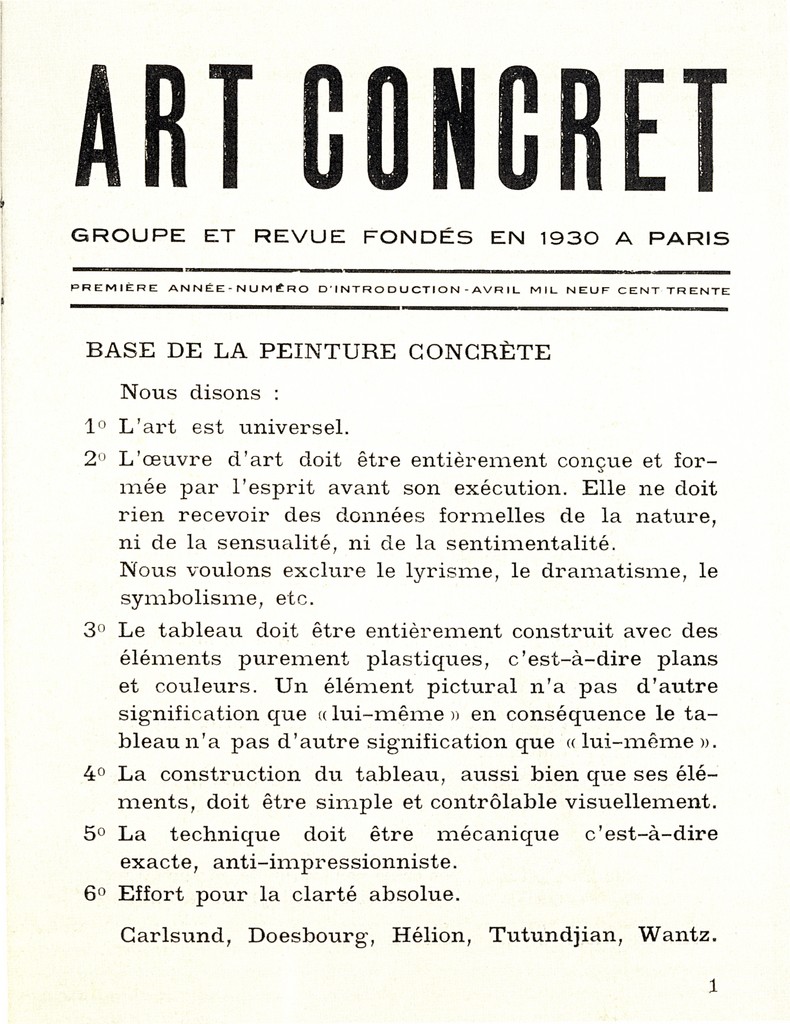Art Concret
Concrete art is abstract art that is entirely free of any basis in observed reality and that has no symbolic meaning.
The term was introduced by artist Theo van Doesburg in his 1930 Manifesto of Concrete Art. The manifesto was published in the first and only issue of the magazine Art Concret. He stated that there was nothing more concrete or more real than a line, a colour, or a plane (a flat area of colour).
In 1930, Dutch artist Theo Van Doesburg and four of his friends openly declared war on every kind of impressionism, sensibility and subjectivity in art. The concrete art group and the magazine Art Concret, which they founded in Paris, argued for rational, universal art “entirely conceived and shaped by the mind”, without “receiving anything from nature’s formal properties, or from sensuality or sentimentality”.
Heir to Mondrian’s neoplasticism and to the principles promoted by the De Stijl movement, concrete art sought “absolute clarity” through a “simple, visually controllable” structure that signified nothing beyond itself. The emotional impulses perceptible in traditional abstraction were excluded in favour of a logical composition based on predetermined mathematical principles.
Concrete art’s Zurich home crystallised a few years later when Max Bill (1908-1994)—influenced by his studies at the Bauhaus and his friendship with members of the Abstraction-Création group in Paris—drew up his own theory on concrete art. Bill advocated a rational art, developed according to its own rules and integrating everyday life. Like the artists of the Allianz association, which Bill joined in 1937, he favoured the use of neutral, geometric, easily understandable shapes.
These Zurich concrete artists—including Richard Paul Lohse (1902-1988), Leo Leuppi, Walter Bodmer, Verena Loewensberg, Camille Graeser (1892-1980), Gottfried Honegger (1917-2016) and Sophie Tauber-Arp—all showed the same predilection for skilfully calculated geometric arrangements. In that vein, Lohse opted for modular compositions in which all elements are mutually supportive, independent and equal; Graeser favoured systematic composition principles like addition, rotation or progression, while Honegger ended up entrusting the production of mathematical calculations to a computer. The visual effect is that of an almost rhythmic chromatic polyphony, which seems to be articulated—as in the works of Fritz Glarner (1899-1972)—according to warm/cool, bright/dark and neutral/intense relationships.
For the artists of concrete art, the work primarily designates a balanced, coherent whole, whose elements are defined by their relationships with one another within the image. These relationships very often become symbols of an ideal, democratic organization, based on all individuals benefiting from the same rights and freedoms.
Art Concret: Movement, Magazine and Manifesto
1. Art is universal.
2. The work of art must be entirely conceived and formed by the mind before its execution. It must receive nothing from nature’s given forms, or from sensuality, or sentimentality.
We wish to exclude lyricism, dramaticism, symbolism, etc.
3. The picture must be entirely constructed from purely plastic elements, that is, planes and colors. A pictorial element has no other meaning than “itself”, and thus the picture has no other meaning than “itself”.
4. The construction of the picture, as well as its elements, must be simple and visually controllable.
5. Technique must be mechanical, that is, exact, anti-impressionistic.
6. Effort for absolute clarity.














